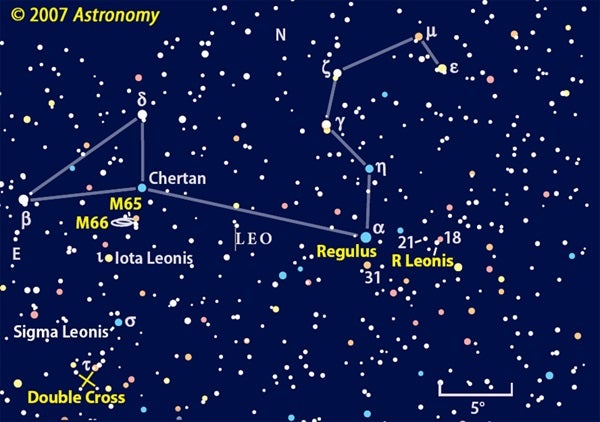Beckoning our attention to Leo in the first place is the sky’s 21st brightest star, Regulus, which marks the lion’s heart. Take a look at Regulus through your binoculars on the next clear night. It’s hard to believe that sparkling star is actually spinning so rapidly its disk is distended into an egg shape. Using instruments atop Mount Wilson in California in 2004, Harold McAlister of Georgia State University and his colleagues found that Regulus’ equatorial diameter is about 1/3 greater than its polar width. That’s quite a midriff bulge!
A careful look with 12x or higher binoculars may show Regulus’ 8th-magnitude companion sun nearly 3′ to the west-northwest. Although the stars are widely separated, Regulus’ glare often consumes the companion. You’ll need a steady hand (or better yet, a tripod) to hold your binoculars still enough to glimpse it. If that proves too tough, pure white Regulus also forms an easy binocular pair with golden 31 Leonis to its south. These two aren’t a true couple, however, but just a chance, line-of-sight pairing.
None of those three stars fluctuates in brightness, and so they serve as useful comparison stars for judging R Leo’s magnitude.
Let’s now shift our attention to eastern Leo. Being far from the Milky Way’s plane, the Lion can’t boast of beautiful star clusters, rich star fields, or glowing nebulosity. But it can flaunt five galaxies from the Messier catalog. The two brightest, M65 and M66, are found southeast of the star Chertan (Theta [θ] Leonis), which marks the right angle in the triangle of stars forming Leo’s back and tail. To find them, drop about half a binocular field (2.5°) south of Chertan to a line of three 7th-magnitude stars. Now, look very carefully about half a field to their east for a very dim smudge of light lying below a faint star. That’s M66. M65 is just west of M66, but, at half a magnitude fainter, is much more challenging. You’ll probably need to brace your binoculars in order to make them out. I can routinely see M66 through my 10x50s from my suburban New York backyard, but M65 takes a better-than-average night.
Finally, follow a zigzag line south of Chertan, past the stars Iota and Sigma Leonis to a small four-star arc that hooks to the southeast. The brightest star in the arc, 4th-magnitude Tau (τ) Leonis, teams with a fainter point to its southeast to create a pretty double star through binoculars. Place Tau toward the upper right (northwest) corner of your field, and carefully look around. You should spot three more faint doubles. Add them together, and you get an asterism that I like to call the Double Cross, because all four pairs collectively fall into an X pattern. None of the four pairs is a true physical binary, however, because all eight stars are located at very different distances. But that doesn’t detract from their unique appearance through our binoculars.
Next month, we’ll use two dogs to hunt more spring targets. Until then, remember that two eyes are better than one.











